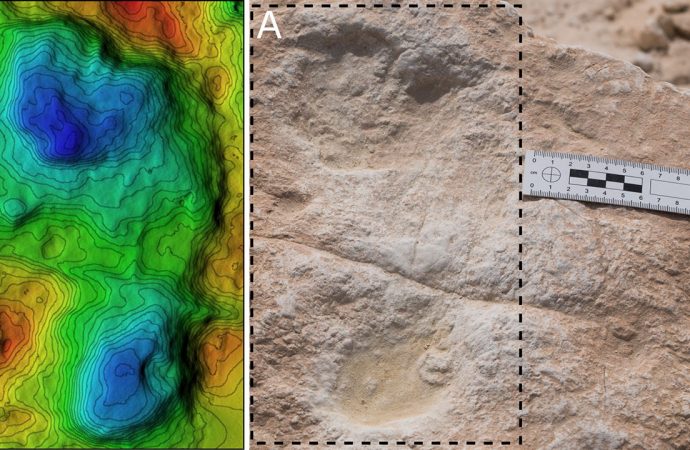One day about 120,000 years ago, a few humans wandered along the shore of an ancient lake in what is now the Nefud Desert in Saudi Arabia. They may have paused for a drink of fresh water or to track herds of elephants, wild asses, and camels that were trampling the mudflats. Within hours of passing through, the humans’ and animals’ footprints dried out and eventually fossilized.
Source: Science Magazine
Now, these ancient footsteps offer rare evidence of when and where early humans once inhabited the Arabian Peninsula. “These are the first genuine human footprints of Arabia,” says archaeologist and team leader Michael Petraglia of the Max Planck Institute for the Science of Human History.
The Arabian Peninsula has long been considered the obvious route that early members of our species took as they trekked out of Africa and migrated to the Middle East and Eurasia. Stone tools have suggested ancient humans explored the Arabian Peninsula at various times in prehistory when the climate was wetter and its harsh deserts were transformed into green grasslands punctuated with freshwater lakes. Yet so far, researchers have only found a single human finger bone dating to 88,000 years to prove modern humans, rather than some other hominin toolmaker, lived there.
After a decade of scouring the Arabian Peninsula using satellite imagery and ground truthing, Petraglia and his international colleagues have identified tens of thousands of ancient freshwater lakebeds, including one in the Nefud dubbed “Alathar,” meaning “the trace” in Arabic. Here, they spotted hundreds of footprints on a heavily trampled lakebed surface, which had recently been exposed when overlying sediments eroded. Almost 400 tracks were left by animals, including a wild ass, a giant buffalo, elephants, and camels. Only seven were confidently identified as human footprints. But by comparing the size and shape of these tracks with those made by modern humans and Neanderthals, the researchers conclude the tracks were likely made by people with longer feet, taller stature, and smaller mass: Homo sapiens, rather than Neanderthals, as they report today in Science Advances.
The age of the sediments also suggests H. sapiens made the tracks, the researchers say. Using a method called optically stimulated luminescence, which measures electrons to infer when layers of sediment were last exposed to light, the team dated the sediments above and below the footprints to 121,000 and 112,000 years.
At that date, “Neanderthals were absent from the Levant [Middle East],” says co-author Mathew Stewart of the Max Planck Institute for Chemical Ecology. “Therefore, we argue that H. sapiens was likely responsible for the footprints.”
A lot rests on the dates, however. Geochronologist Bert Roberts of the University of Wollongong notes some uncertainties with dating methods at the site—including older ages for animal fossils and potential issues with calculating the precise rate of decay of uranium in the sediments. The dates for the footprints “might be in the right ballpark,” he says, “but more could be done to validate them.”
The team can’t entirely exclude Neanderthals, says paleoanthropologist Marta Mirazón Lahr of the University of Cambridge, because the fossil record is so spotty in Arabia. But she thinks H. sapiens is the more likely candidate.
Even more intriguing, she notes, the footprints show the humans were capable of moving long distances between Africa and Arabia and must have had fairly large foraging parties to have been able to penetrate deep into the rich interior wetlands of Arabia.
The rare association of human and animal footprints laid down in the same day or so also offers a rare glimpse of a day in the life of an ancient human. Usually, animal and human fossils found in the same fossil bed were buried hundreds, if not thousands, of years apart and never laid eyes on each other. “These footprints give us a unique snapshot of the humans living in this area at the same time as the animals,” says paleoanthropologist Kevin Hatala of Chatham University in Pittsburgh, an expert on ancient footprints. “That tight association in time is what’s so exciting to me.”
Source: Science Magazine

































Leave a Comment
You must be logged in to post a comment.